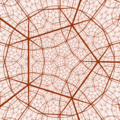ముఖం (జ్యామితి)
ముఖం అనునది "ఘన జ్యామితి"లో ఒక ఘనాకృతిలోగల వస్తువు యొక్క ఉపరితలం పై ఆవరించియున్న సమతల తలం[1] ఒక త్రిపరిమాణం కలిగి సమతల ముఖాలతో ఆవరించియున్న ఘనాకృతిని పాలీహైడ్రన్ అంటారు. జ్యామితిలో పాలీహైడ్రా, ఉన్నత పరిమాన పాలీటోప్ ల యొక్క అనేక సాంకేతిక పదజాలాలలో ఉపయోగిస్తారు.[2]
బహుభుజి ముఖం
[మార్చు]ప్రాథమిక జ్యామితిలో, పాలిహైడ్రన్ యొక్క ఆవరణ పై గల ద్వి పరిమాణ బహుభుజిని "ముఖం" అంటారు[2][3] . బహుభుజి యొక్క ఇతర పేర్లలో పాలిహైడ్రన్ యొక్క భుజం, యూక్లిడియన్ తలం యొక్క టైల్ అని పిలుస్తారు.
ఉదాహరణకు, ఆరు చతురస్రాకార ముఖాలు ఒక "సమఘనాన్ని" ఏర్పరుస్తాయి. కొన్ని సార్లు "ముఖం" అనే పదం "4=పాలిటోప్" యొక్క ద్వి పరిమాణ ధర్మాలు కలిగినది. దీని అర్థము 4- పరిమాణం గల "టెసెరాక్ట్"లో 24 చదరాకార ముఖాలు ఉంటాయి. ప్రతీది ఎనిమిది ఘనాకార చదరాలలో రెండు పంచుకొని ఉంటాయి.
| Polyhedron | Star polyhedron | Euclidean tiling | Hyperbolic tiling | 4-polytope |
|---|---|---|---|---|
| {4,3} | {5/2,5} | {4,4} | {4,5} | {4,3,3} |
 The cube has 3 square faces per vertex. |
 The small stellated dodecahedron has 5 pentagrammic faces per vertex. |
 The square tiling in the Euclidean plane has 4 square faces per vertex. |
 The order-5 square tiling has 5 square faces per vertex. |
 The tesseract has 3 square faces per edge. |
Some other polygons, which are not faces, are also important for polyhedra and tessellations. These include Petrie polygons, vertex figures and facets (flat polygons formed by coplanar vertices which do not lie in the same face of the polyhedron).
k-ముఖం
[మార్చు]In higher-dimensional geometry the faces of a polytope are features of all dimensions.[2][4][5] A face of dimension k is called a k-face. For example the polygonal faces of an ordinary polyhedron are 2-faces. In set theory, the set of faces of a polytope includes the polytope itself and the empty set where the empty set is for consistency given a "dimension" of −1. For any n-polytope (n-dimensional polytope), −1 ≤ k ≤ n.
For example, with this meaning, the faces of a cube include the empty set, its vertices (0-faces), edges (1-faces) and squares (2-faces), and the cube itself (3-face).
All of the following are the faces of a 4-dimensional polytope:
- 4-face – the 4-dimensional 4-polytope itself
- 3-faces – 3-dimensional cells (polyhedral faces)
- 2-faces – 2-dimensional faces (polygonal faces)
- 1-faces – 1-dimensional edges
- 0-faces – 0-dimensional vertices
- the empty set, which has dimension −1
In some areas of mathematics, such as polyhedral combinatorics, a polytope is by definition convex. Formally, a face of a polytope P is the intersection of P with any closed halfspace whose boundary is disjoint from the interior of P.[6] From this definition it follows that the set of faces of a polytope includes the polytope itself and the empty set.[4][5]
In other areas of mathematics, such as the theories of abstract polytopes and star polytopes, the requirement for convexity is relaxed. Abstract theory still requires that the set of faces include the polytope itself and the empty set.
సెల్ లేదా 3-ముఖం
[మార్చు]A cell is a polyhedral element (3-face) of a 4 dimensional polytope or 3 dimensional tessellation, or higher. Cells are facets for 4-polytopes and 3-honeycombs.
ఉదాహరణలు:
| 4-polytopes | 3-honeycombs | ||
|---|---|---|---|
| {4,3,3} | {5,3,3} | {4,3,4} | {5,3,4} |
 The tesseract has 3 cubic cells (3-faces) per edge. |
 The 120-cell has 3 dodecahedron cells (3-faces) per edge. |
 The cubic honeycomb fills Euclidean 3-space with cubes, with 4 cells (3-faces) per edge. |
 The order-4 dodecahedral honeycomb fills 3-dimensional hyperbolic space with dodecahedra, 4 cells (3-faces) per edge. |
ఫాసెట్ (Facet) లేదా (n-1)-ముఖం
[మార్చు]In higher-dimensional geometry, the facets of a n-polytope are the (n-1)-faces of dimension one less than the polytope itself.[7] For example:
- The facets of a line segment are its 0-faces or vertices.
- The facets of a polygon are its 1-faces or edges.
- The facets of a polyhedron or plane tiling are its 2-faces.
- The facets of a 4-polytope or 3-honeycomb are its 3-faces.
- The facets of a 5-polytope or 4-honeycomb are its 4-faces.
రిడ్జ్ (Ridge) or (n-2)-ముఖం
[మార్చు]In related terminology, a (n − 2)-face of an n-polytope is called a ridge.[8]
పీక్ (peak) లేదా (n-3)-ముఖం
[మార్చు]A (n − 3)-face of an n-polytope is called a peak.
ఇవి కూడా చూడండి
[మార్చు]మూలాలు
[మార్చు]- ↑ Merriam-Webster's Collegiate Dictionary (Eleventh ed.). Springfield, MA: Merriam-Webster. 2004.
- ↑ 2.0 2.1 2.2 Matoušek, Jiří (2002), Lectures in Discrete Geometry, Graduate Texts in Mathematics, vol. 212, Springer, 5.3 Faces of a Convex Polytope, p. 86.
- ↑ Cromwell, Peter R. (1999), Polyhedra, Cambridge University Press, p. 13.
- ↑ 4.0 4.1 Grünbaum, Branko (2003), Convex Polytopes, Graduate Texts in Mathematics, vol. 221 (2nd ed.), Springer, p. 17.
- ↑ 5.0 5.1 Ziegler, Günter M. (1995), Lectures on Polytopes, Graduate Texts in Mathematics, vol. 152, Springer, Definition 2.1, p. 51.
- ↑ Matoušek (2002) and Ziegler (1995) use a slightly different but equivalent definition, which amounts to intersecting P with either a hyperplane disjoint from the interior of P or the whole space.
- ↑ Matoušek (2002), p. 87; Grünbaum (2003), p. 27; Ziegler (1995), p. 17.
- ↑ Matoušek (2002), p. 87; Ziegler (1995), p. 71.
